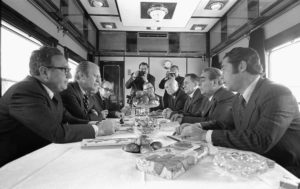December 12, 2016
Nikolai Sokov
US-Russian nuclear arms control has remained deadlocked since the conclusion of the New Strategic Arms Reduction Treaty (New START) in 2010. The absence of progress hasn’t, however, been a major concern in either country. Although the United States could benefit from additional reductions as it considers the wholesale replacement of its strategic delivery vehicles, that interest appears rather marginal. Russia, already in the midst of its own delivery-vehicle replacement program, seems even less interested.

President Gerald Ford, Secretary of State Henry Kissinger, and other US representatives meeting with General Secretary Leonid Brezhnev, Foreign Secretary Andrei Gromyko, Ambassador Anatoly Dobrynin, and others aboard a Russian train headed for Vladivostok, November 23, 1974. Image courtesy of the Gerald R. Ford Presidential Library. (Src: Wikimedia Commons)
Nuclear-arms reductions beyond New START have remained highly controversial. Although advocated by the Barack Obama administration, most of Congress remained skeptical or opposed. Now is the time to move beyond this previously tolerated deadlock and for the United States to engage in arms control.
The reason for a new US policy toward Russia is not nuclear weapons, but rather the other, non-nuclear capabilities, which have been, until now, the sole domain of the United States. Russia, which has achieved parity with the United States in nuclear weapons, is in the final stages of acquiring critical non-nuclear capabilities, which are not regulated by international regimes, primarily because Washington has resisted such limitations. If the situation remains unchanged, the United States will face unrestricted arms races in several key weapons categories and an increased risk of direct military confrontation with Russia (or between Russia and US allies, friends, and clients) with unpredictable escalatory paths. For that reason, a new effort at an agreement with Russia will be in the US national interest and should transcend ideological, political, or party divides.
